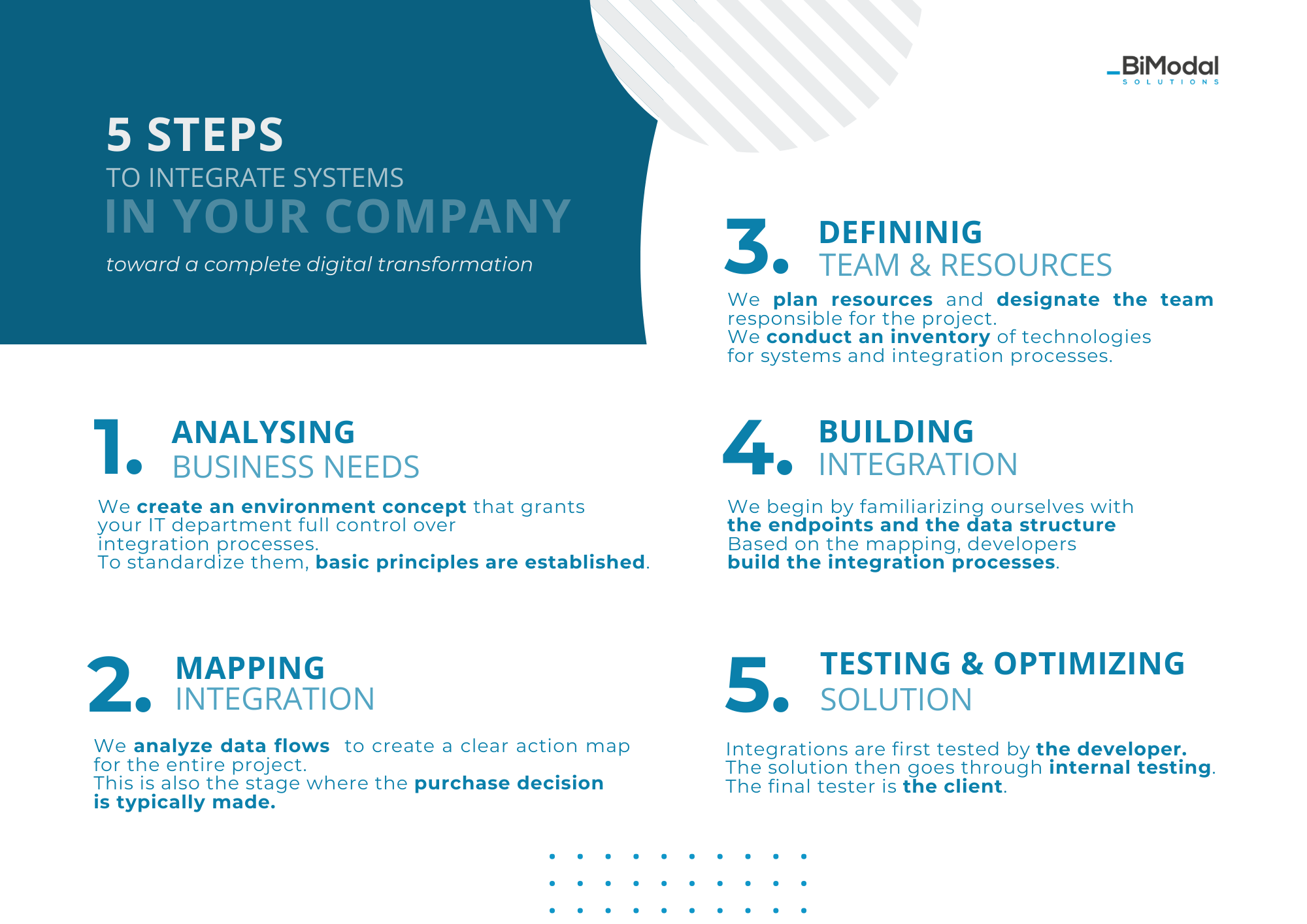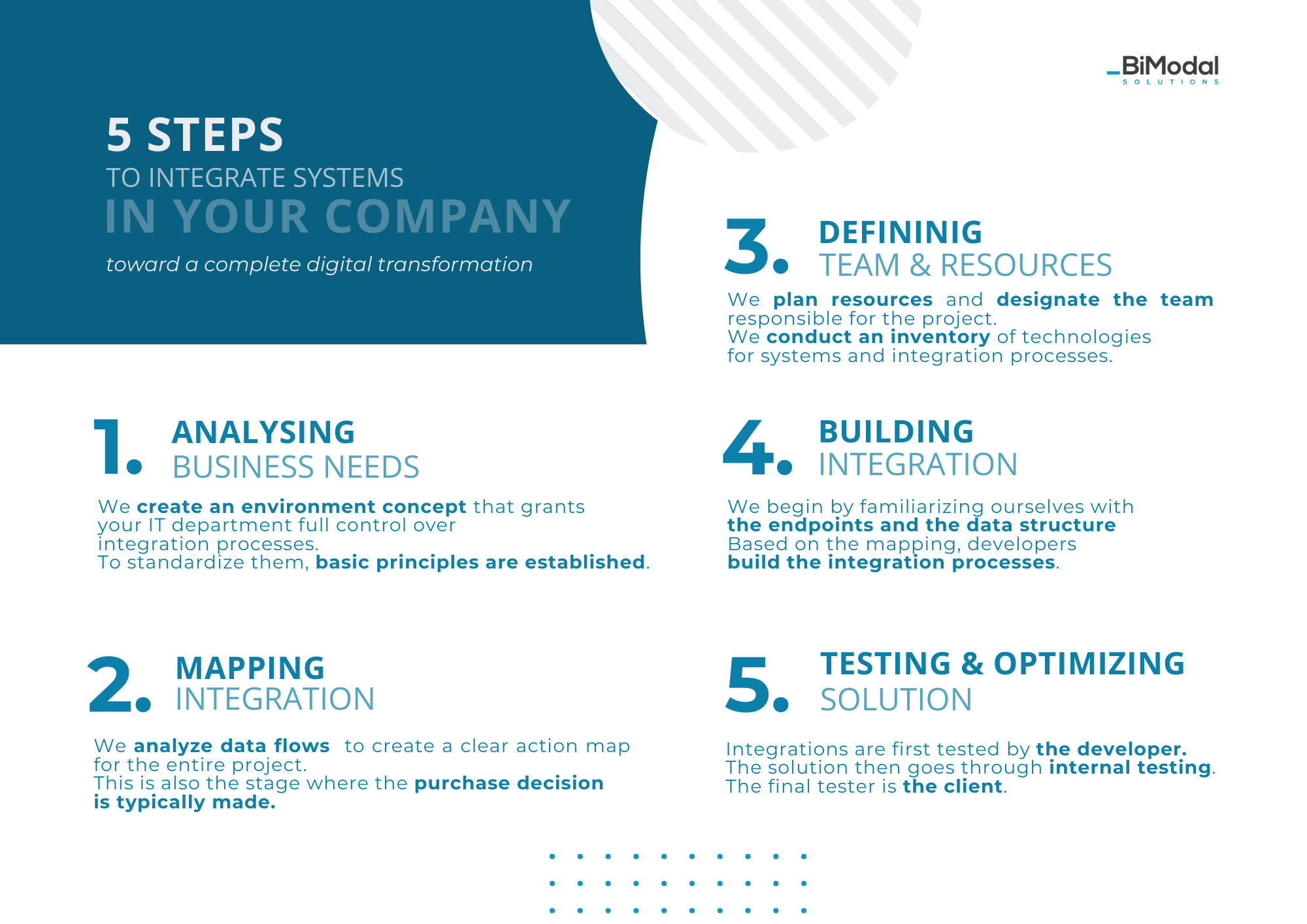Implementing major IT changes comes with uncertainties. That’s why it often meets resistance - especially when existing solutions still function.
However, innovation is sometimes essential. That’s why we’ve outlined key steps that help structure the transition and ensure a smoother experience. Explore them with us!
Boomi IT integration
step 1: business needs analysis
Before implementing the Boomi system integration, we identify your business challenges and objectives. IT departments prioritize control and visibility, but scattered integrations from turnover and ad-hoc demands make standardization difficult.
At BiModal Solutions, we address this through in-depth consultations to design customized solutions that fit your needs. By focusing on strategic integration areas, we ensure efficiency without overwhelming your business.
Key questions we ask at this stage:
- Which processes require automation or improvement?
- What systems and applications need to be integrated?
- How many systems do you have, and which ones do you want to integrate now?
- What benefits should the integration deliver?
Boomi system integration
step 2: mapping integration processes
Now that we’ve set our goals, we help clients translate business challenges into technical requirements, ensuring every step addresses real needs efficiently. After discussing solutions, companies often make their purchase decision.
Once needs are defined, we map data flows and business processes, working closely with IT teams. Business Development Managers may join later, adding insights on operations and system functionalities.
Key questions we ask at this stage:
- What data flows between the systems?
- Where are the critical points and potential bottlenecks?
- Which processes need improvement?
Implementing the Boomi platform
step 3: defining team and resources
Every project requires a dedicated coordinator to ensure a controlled Boomi implementation and a smooth integration process. This role is typically filled by a Project Manager or a Solution Architect, and sometimes by a professional focused on business outcomes.
To streamline communication, we assign a specialist to oversee the project. For such innovative technologies as Boomi, it’s worth considering working with an authorized partner who can manage critical operations and IT infrastructure, minimizing the risk of irreversible issues.
Key questions we ask at this stage:
- Who will be responsible for the project?
- What skills are required?
- Is it worth involving an external technology partner?
Boomi implementation
step 4: creating integration processes
Now, we move on to the practical Boomi implementation, guided by the existing IT infrastructure and system landscape. We help clients create and execute a phased plan, ensuring clear communication and post-release support for future integrations.
The process starts with analyzing endpoints and data structures before developers build integrations using the Boomi platform. Here, we can witness both the benefits of Agile methodology and Boomi’s efficiency in all glory — e.g. one client integrated 14 systems into a cohesive whole in just two years.
How do we help?
- Gradual testing and error elimination
- Continuous monitoring of results
- Improved resource and time management
Boomi system integration
step 5: testing and optimization
To ensure the stability of our solutions, we conduct a comprehensive testing and optimization process. This allows us to confirm that the connectors function smoothly and efficiently.
The process typically occurs in three stages.
- First, a connection is established and tested by a developer.
- Next, the solution is assessed during an internal testing phase.
- Finally, it undergoes additional testing within the company using small volumes of data.
What do we pay attention to?
- Stability of data flows,
- Performance and speed of processes,
- Further opportunities for optimization and expansion.
5 steps to implement the Boomi platform:
the conclusion
 With constant market flux, we predict that introducing integration processes will become increasingly important in the near future. That is why it’s essential to plan this process and rely on an expert's view.
With constant market flux, we predict that introducing integration processes will become increasingly important in the near future. That is why it’s essential to plan this process and rely on an expert's view.
Are you ready for IT integration with Boomi? Work with us! As Boomi Silver Partners, we boast dozens of successful system integration projects. Our approach allows us to create unique solutions to match each client’s needs.

